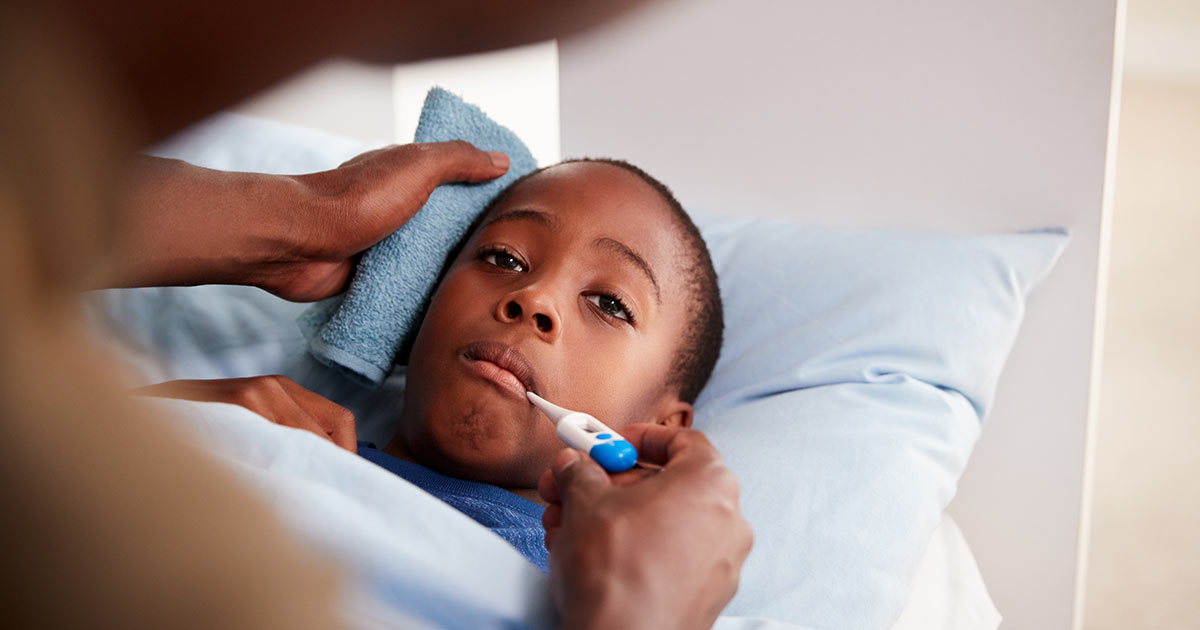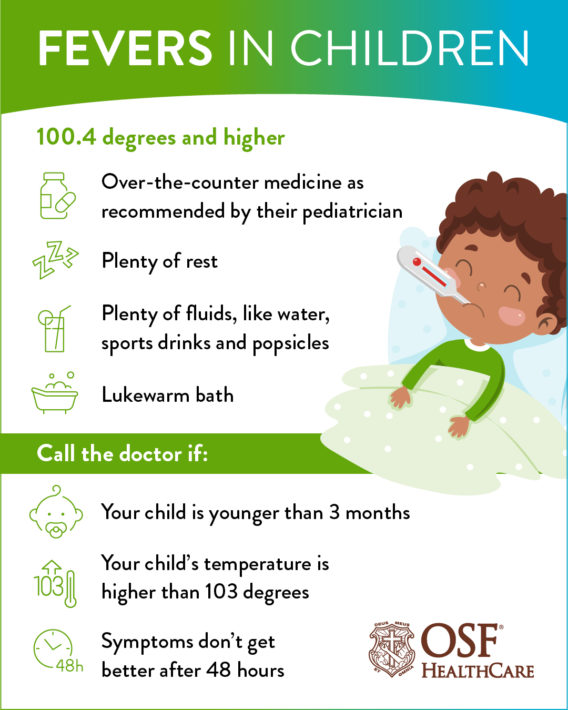
What is considered a fever in children?
Parenting is difficult. Throw in a fever, and your anxiety level can skyrocket. While your child’s temperature may make you wonder if they’re sick, typically, a hot forehead is nothing to lose your cool over.
What is a fever?
Fevers are not a medical condition. Fevers are our body’s natural defense to fight infection. They happen when certain metabolic processes speed up to help our immune system join the fight.
Causes of fever
Fever won’t go away?
Kids can feel warm for many reasons – crying, playing, teething, snuggling in a warm bed or hot weather.
Other reasons your child may have a fever:
- Viral infection, like a cold, the flu or COVID-19
- Bacterial infection, like an ear infection or strep throat
- Allergic reaction
When it’s a fever from an illness, your child likely will show other symptoms, like tiredness, fussiness, chills, runny or stuffy nose or cough. If you think your child has been exposed to COVID-19, visit Clare, the OSF HealthCare chatbot. Clare can screen your child’s symptoms and direct you to needed care and support.
What temperature is a fever for a child?

Feeling your child’s forehead is not enough. You need to take their temperature to get an accurate reading. The American Academy of Pediatrics (AAP) recommends you use a digital thermometer. It’s best to take the temperature rectally for children ages three and younger.
A normal temperature for a healthy child is between 97.7 degrees and 99.5 degrees. However, everyone’s temperature rises around 6 p.m. We just don’t recognize it when we’re healthy. So, if your child already has a fever, the addition of the body’s normal temperature increase to the fever can cause a spike in the evening. Unfortunately, that’s usually when the doctor’s office has closed for the day.
A temperature of more than 100.4 degrees is considered a fever. Usually, anything below 99 degrees isn’t considered a fever. When taken orally, a temperature higher than 99.5 degrees is diagnosed as a low-grade fever.
For an easy way to know when your child has a fever, reference this child fever temperature chart:
- Normal temperature range: 97.7°F to 99.5°F
- Low-grade fever: 99.6°F to 100.3°F
- Fever: 100.4°F or higher
When to worry about your child’s fever
Typically, if your child is behaving normally, there is no need for any fever-lowering treatment. The AAP recommends you check with your health care provider if:
- Age 3 months or younger: Rectal temperature of 100.4 degrees or higher – should be seen immediately. Call your primary care provider or go to the nearest emergency department.
- Younger than age 2: Fever lasts more than 24 hours
- Ages 2 and older: Fever lasts more than 72 hours
- Any age: Fever repeatedly goes higher than 104 degrees or is accompanied by other symptoms, such as having a seizure, severe sore throat, severe abdominal or ear pain, severe headache, unexplained rash, repeated vomiting or diarrhea, stiff neck, unusual sleepiness or very fussy behavior, blue lips, tongue or nails, or if the child’s condition has worsened since a previous doctor visit.
How to reduce and treat a fever
Even if your child acts normally with a fever, their body is still working hard to fight some sort of infection. You can help their body to break the fever and get better faster by treating their fever.
Do:
- Make sure they get plenty of rest
- Give plenty of fluids, like water, sports drinks and popsicles
- Give a lukewarm bath
- Give fever-reducing medicine as directed by your child’s pediatrician or what’s on the medicine label
Don’t:
- Let your child around other children – they may still be contagious
- Over-exert themselves even if they are acting normally
If the child is not acting bothered by the temperature, I usually tell my parents to hold off on giving acetaminophen or ibuprofen for a fever between 100.4 degrees and 102 degrees. However, if the child is acting lethargic,
having pain or not wanting to drink fluids, I recommend giving medications. Children can start to become uncomfortable with a 102 fever or 103 fever.
Pain will not allow the child to rest well, which is one of the best things someone can do to fight infection.
You may have heard the old adage, “Feed a cold, starve a fever.” But that advice is outdated. If your child feels hungry, feed them healthy foods. Having nutritious foods and drinks while sick can help them to get better. Decreased fluids may cause dehydration. So, pay attention to how your child is acting and how they look. You know your child better than anyone else.
Fever-reducing medicine
Whenever you give your child medicine, it’s important to follow the best guidelines.
- If your child is younger than 2 years old, call your health care provider or pharmacist to find out how much medicine is recommended.
- If your child is older than 2, follow the label instructions for the specific medication.
- If your child is younger than 3 months, check with your health care provider before giving acetaminophen.
- Do not give ibuprofen to your child if they are younger than 6 months, dehydrated or vomiting. If the fever is treated with acetaminophen or ibuprofen but still hasn’t gone down after one to four hours, you should inform your health care provider.
- Do not give aspirin to children or teens. Aspirin use by young people with viral illnesses has been linked to Reye syndrome, a rare but serious disease.
A common report I get from patients in the office is that they didn’t give their child any medication before they came in because they wanted me to see their child’s fever and not mask any symptoms. Please do not feel that this is necessary. No one wants a child to suffer from the side effects of fever if they do not have to. We will believe you.
How long does a fever last?
It’s normal for fevers from viral infections to last for two or three days. The fever will likely come back after the fever medicine wears off. However, the fever will not return once the body overpowers the infection. Typically, this can take three to four days.
Staying hydrated
Fever can lead to dehydration. It’s essential your child gets enough liquids, especially if you breastfeed. Contact your health care provider if your child refuses to drink or shows signs of dehydration, such as:
- A sunken fontanel (soft spot on the top of the baby’s head)
- Dry mouth and lips
- Lack of tears
- Sunken eyes
- General look of illness
Warnings about fevers
There are times when a fever can lead to a febrile seizure or convulsion – particularly in children between the ages of three months and five years. Although scary, febrile seizures usually only last a few minutes and are not dangerous, but you should still inform your health care provider.
It’s also important to tell your pediatrician if your child develops a fever after traveling. Special tests can be ordered to find out if your child picked up an infection while on your trip.
Fever alone is only rarely harmful and usually remains below 105.8 degrees
When is a fever too high for a child?
Our brain knows when our body is getting too hot and is wonderfully designed to regulate our temperature, keeping fevers due to infection from going over 103 degrees or 104 degrees. They rarely go to 105 degrees or 106 degrees.
While these are “high” fevers, you don’t need to be alarmed because fevers with infections don’t rise high enough to cause brain damage. When your body temperature rises above 108 degrees, it is possible to get brain damage. But temperatures that cause brain damage are caused by surrounding temperatures being high – like the inside of a car, with the windows up on a hot summer day.
Remember, fever is one of the good guys.
Fever is a mechanism that the body uses to combat infection, helping to kill bacteria and viruses by boosting the production of infection-fighting white blood cells. Typically, you don’t need to worry about reducing the fever unless your child is uncomfortable.
If you can’t get your child’s fever down, call your pediatrician. Be prepared with how high the fever has been, for how long and how much and when acetaminophen or ibuprofen was given. This information can help us provide you with advice over the phone and possibly save you a trip to the office or emergency room.